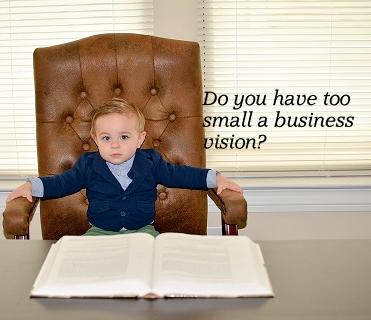Every entrepreneur hopes to make sales and see their business take off, but what happens when it does and you fail to move with it? This podcast episode explores the too small business vision and how to prepare for growth.
I recently encountered an article about a young woman, Danielle Baskin, who is a gold mine of ideas that she turns into businesses. The article was titled “An entrepreneur Juggles Six Companies and One Worker: Herself” While I marveled at this young woman’s creative imagination I also took note of the fact that she grudgingly moved to automate some of her functions and take on a small staff. Reading her progression in growing her business I was reminded that we often visualize the beginning of a business idea but forget to keep dreaming to expand it and fall victim to what I call the “small” small business syndrome.
Ms. Baskin started out as an art student who liked making the fun helmets she wore when riding her bike. People started asking where she got them and from there she got the idea to create them as a product. When she couldn’t get any brick and mortar stores to carry them, she responded with that stubborn streak entrepreneurs get that set off the idea of going the ecommerce route. It was only when the orders started coming in that she struggled with getting beyond her original vision of them actually selling.
Many with the “small” small business mindset begin to limit their vision to their original concept by continuing to see themselves doing all the work and the business being their baby. The pivotal point for Ms. Baskin was the day she received an order for 200 helmets and couldn’t fill it, not because she didn’t have the capital she needed, but because she could not do all the work herself. A lot of time and effort goes into tapping into the market you think is out there, but from the moment you start getting orders the vision needs to start morphing into planning what changes you might have to make if the trend continues.
Begin to look at your processes
I firmly believe in multiplication of effort. Are there new tools or a different approach that will allow you to create more without damaging your brand? What instantly came to mind for me in this case was the graffiti artist Banksy. He creates stencils to quickly complete his street art before the police arrive. In the same way automate as much as possible to  speed up production. It may mean hiring a worker or two for prep work leaving you time to add the touches that make your product stand out. You working alone was the beginning vision but is not a long term strategy for growth.
speed up production. It may mean hiring a worker or two for prep work leaving you time to add the touches that make your product stand out. You working alone was the beginning vision but is not a long term strategy for growth.
Plan to grow into your space
Starting out in your spare bedroom only works for a while, but as growth comes so does the need for more space. That does not mean go out and get a swank office or an expensive warehouse. Sometimes a dumpy location is just the ticket in price and space required. Look for something that takes in account plans for growth. You may start out in a small portion of the dumpy building and as business picks up you can gradually expand to fill the rest of the space. Nothing eats up more time and effort than finding a location and then having to move because you’ve quickly outgrown it.
Think of ways to diversify
Diversify into other product areas that may complement the product that has taken off. In Ms. Baskin case it would be a small jump from bicycle helmet to say motorcycle helmets. Going in this direction allows you to use the social proof of the original product while also creating a different income stream. If the original product tapers off you’ve got somewhere else to go with product development.
Tap into a social group of creators
Cross pollination is a beautiful thing when people doing something completely different than you are able to provide ideas that can be reworked to fit your situation. This can be accomplished by effective using social media to meet others with ideas, collaborating on projects when you get the chance, or becoming a member of a business organization. Each will help you keep up with changes in processes in addition to technology that will help to make your work life easier to keep track of.
It took awhile for all of this to sink in for Ms. Baskin, but I’m happy to say that she began to see the need to grow out of her small small business mindset and instituted a number of the points I mentioned including moving from NY to California, becoming better at marketing, and finally realizing that to really grow her business she needs not just a few hired employees but a “small team” to keep up with the ideas she seems to generate. A happy ending indeed!


